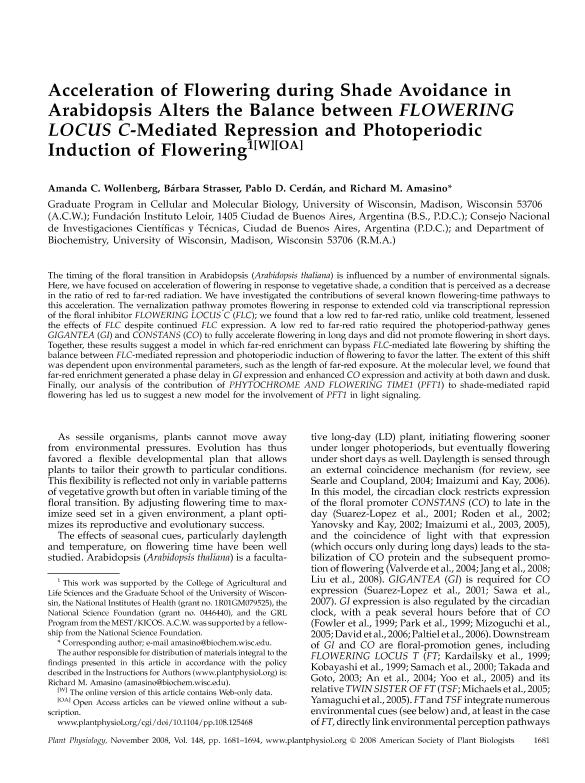Mostrar el registro sencillo del ítem
dc.contributor.author
Wollenberg, Amanda C.
dc.contributor.author
Strasser, Bárbara
dc.contributor.author
Cerdan, Pablo Diego

dc.contributor.author
Amasino, Richard M.
dc.date.available
2017-07-21T19:49:59Z
dc.date.issued
2008-09
dc.identifier.citation
Wollenberg, Amanda C.; Strasser, Bárbara; Cerdan, Pablo Diego; Amasino, Richard M.; Acceleration of flowering during shade avoidance in Arabidopsis alters the balance between FLOWERING LOCUS C-mediated repression and photoperiodic induction of flowering.; American Society of Plant Biologist; Plant Physiology; 148; 3; 9-2008; 1681-1694
dc.identifier.issn
0032-0889
dc.identifier.uri
http://hdl.handle.net/11336/21117
dc.description.abstract
The timing of the floral transition in Arabidopsis (Arabidopsis thaliana) is influenced by a number of environmental signals. Here, we have focused on acceleration of flowering in response to vegetative shade, a condition that is perceived as a decrease in the ratio of red to far-red radiation. We have investigated the contributions of several known flowering-time pathways to this acceleration. The vernalization pathway promotes flowering in response to extended cold via transcriptional repression of the floral inhibitor FLOWERING LOCUS C (FLC); we found that a low red to far-red ratio, unlike cold treatment, lessened the effects of FLC despite continued FLC expression. A low red to far-red ratio required the photoperiod-pathway genes GIGANTEA (GI) and CONSTANS (CO) to fully accelerate flowering in long days and did not promote flowering in short days. Together, these results suggest a model in which far-red enrichment can bypass FLC-mediated late flowering by shifting the balance between FLC-mediated repression and photoperiodic induction of flowering to favor the latter. The extent of this shift was dependent upon environmental parameters, such as the length of far-red exposure. At the molecular level, we found that far-red enrichment generated a phase delay in GI expression and enhanced CO expression and activity at both dawn and dusk. Finally, our analysis of the contribution of PHYTOCHROME AND FLOWERING TIME1 (PFT1) to shade-mediated rapid flowering has led us to suggest a new model for the involvement of PFT1 in light signaling.
dc.format
application/pdf
dc.language.iso
eng
dc.publisher
American Society of Plant Biologist

dc.rights
info:eu-repo/semantics/openAccess
dc.rights.uri
https://creativecommons.org/licenses/by-nc-sa/2.5/ar/
dc.subject
Arabidopsis
dc.subject
Floracion
dc.subject
Fitocromo
dc.subject
Pft1
dc.subject.classification
Bioquímica y Biología Molecular

dc.subject.classification
Ciencias Biológicas

dc.subject.classification
CIENCIAS NATURALES Y EXACTAS

dc.title
Acceleration of flowering during shade avoidance in Arabidopsis alters the balance between FLOWERING LOCUS C-mediated repression and photoperiodic induction of flowering.
dc.type
info:eu-repo/semantics/article
dc.type
info:ar-repo/semantics/artículo
dc.type
info:eu-repo/semantics/publishedVersion
dc.date.updated
2017-07-18T14:50:27Z
dc.identifier.eissn
1532-2548
dc.journal.volume
148
dc.journal.number
3
dc.journal.pagination
1681-1694
dc.journal.pais
Estados Unidos

dc.journal.ciudad
Rockville
dc.description.fil
Fil: Wollenberg, Amanda C.. University of Wisconsin; Estados Unidos
dc.description.fil
Fil: Strasser, Bárbara. Consejo Nacional de Investigaciones Científicas y Técnicas. Oficina de Coordinación Administrativa Parque Centenario. Instituto de Investigaciones Bioquímicas de Buenos Aires. Fundación Instituto Leloir. Instituto de Investigaciones Bioquímicas de Buenos Aires; Argentina
dc.description.fil
Fil: Cerdan, Pablo Diego. Consejo Nacional de Investigaciones Científicas y Técnicas. Oficina de Coordinación Administrativa Parque Centenario. Instituto de Investigaciones Bioquímicas de Buenos Aires. Fundación Instituto Leloir. Instituto de Investigaciones Bioquímicas de Buenos Aires; Argentina
dc.description.fil
Fil: Amasino, Richard M.. University of Wisconsin; Estados Unidos
dc.journal.title
Plant Physiology

dc.relation.alternativeid
info:eu-repo/semantics/altIdentifier/url/http://www.plantphysiol.org/content/148/3/1681.long
dc.relation.alternativeid
info:eu-repo/semantics/altIdentifier/doi/https://doi.org/10.1104/pp.108.125468
Archivos asociados
